Research Project: Leadership Impact on Engagement at ICICI Bank
VerifiedAdded on 2023/05/28
|14
|3463
|297
Project
AI Summary
This industry research project investigates the impact of leadership on employee engagement and wellbeing at ICICI Bank in Andhra Pradesh, India. The research aims to evaluate how leadership styles affect the management of diversity within the workplace. It addresses the problem of communication gaps and lack of wellbeing initiatives affecting employee engagement. The research questions explore the conceptual understanding of leadership, its effect on employee wellbeing and engagement, the roles and responsibilities of leaders, and how leadership can be improved. The literature review examines various leadership styles, including transformational and participative leadership, and their impact on employee motivation, teamwork, and overall wellbeing. The chosen research methodology is a mixed-methods approach, combining quantitative and qualitative data collection techniques. Primary data will be gathered through surveys, and secondary data will be obtained from a literature review. The proposed sample includes 50 employees from ICICI Bank.
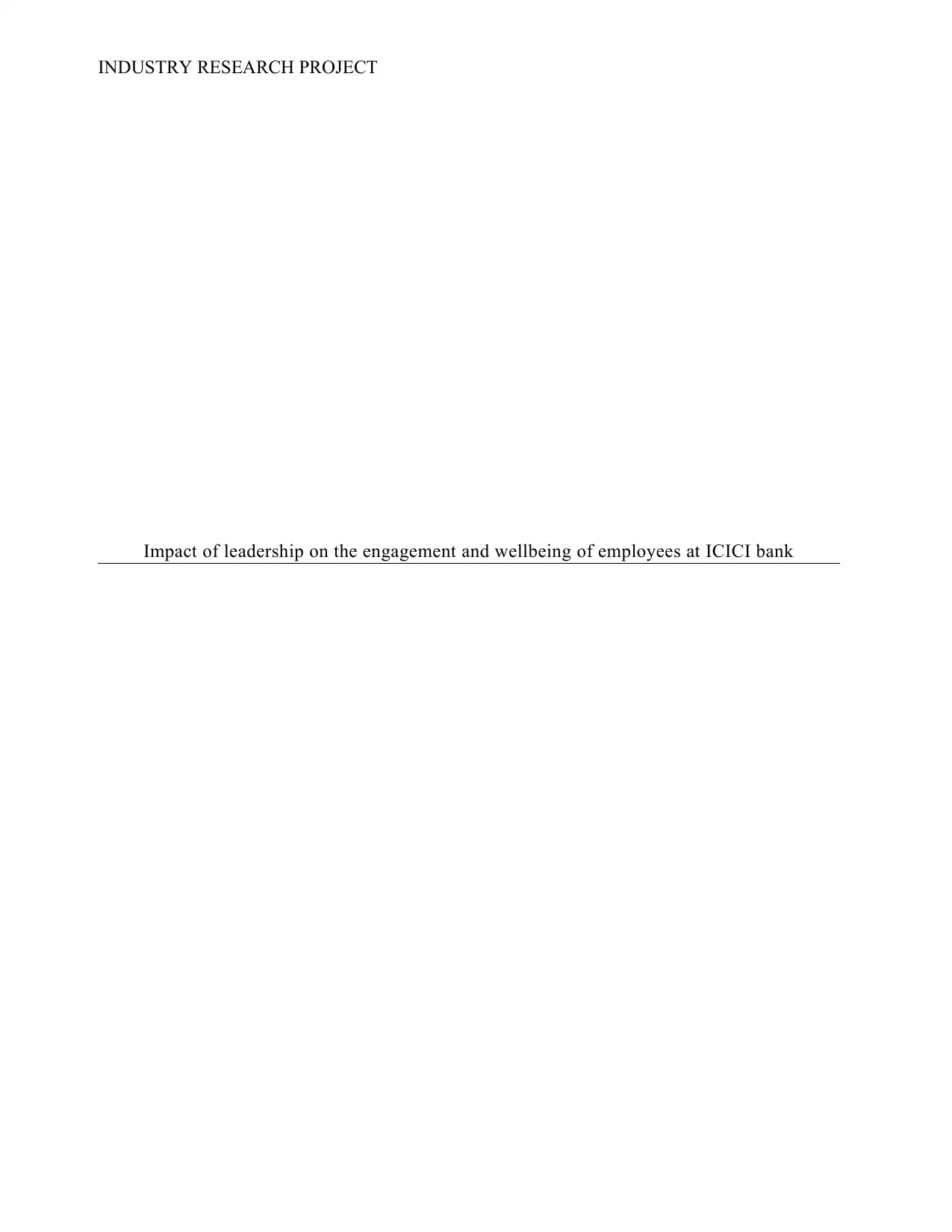
INDUSTRY RESEARCH PROJECT
Impact of leadership on the engagement and wellbeing of employees at ICICI bank
Impact of leadership on the engagement and wellbeing of employees at ICICI bank
Paraphrase This Document
Need a fresh take? Get an instant paraphrase of this document with our AI Paraphraser
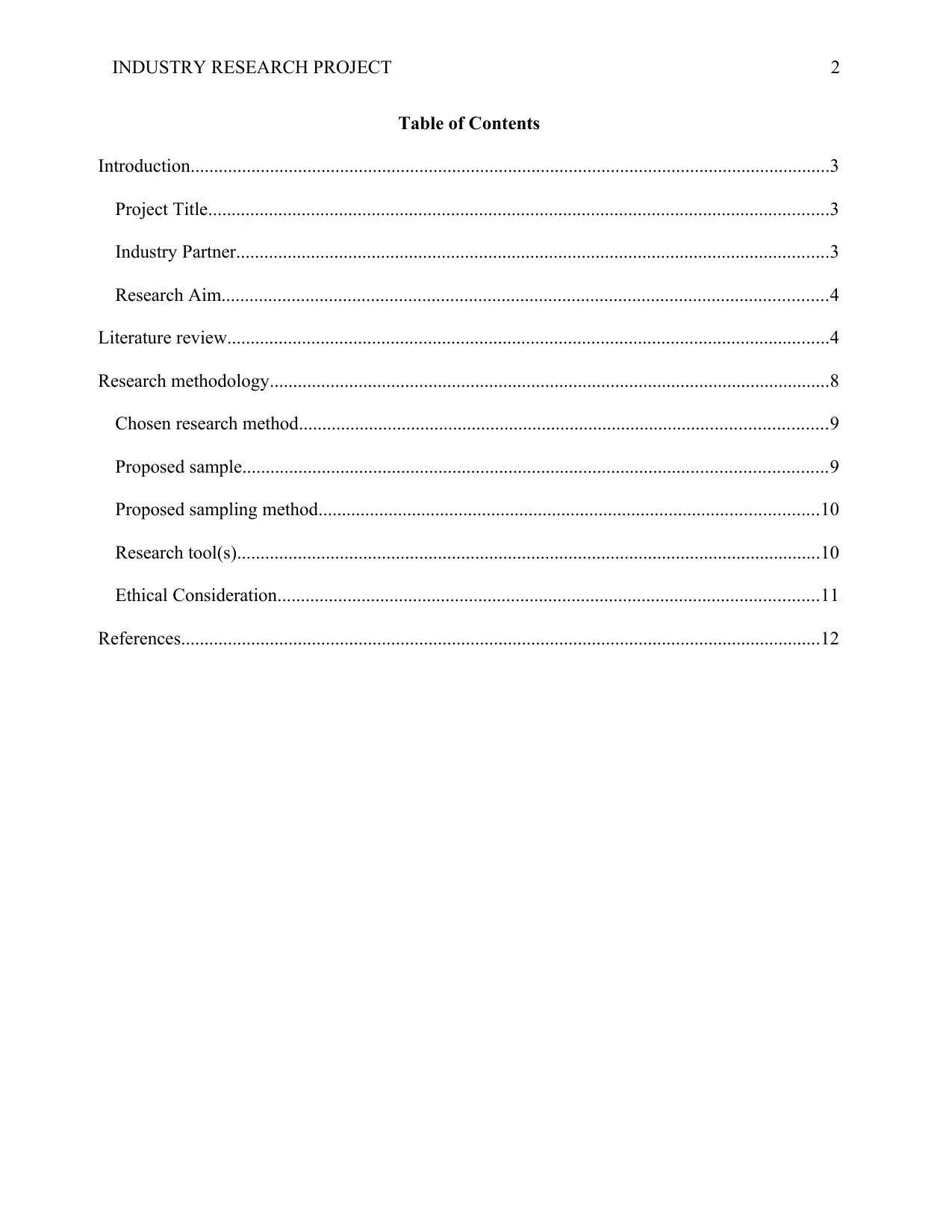
INDUSTRY RESEARCH PROJECT 2
Table of Contents
Introduction.........................................................................................................................................3
Project Title.....................................................................................................................................3
Industry Partner...............................................................................................................................3
Research Aim..................................................................................................................................4
Literature review.................................................................................................................................4
Research methodology........................................................................................................................8
Chosen research method.................................................................................................................9
Proposed sample.............................................................................................................................9
Proposed sampling method...........................................................................................................10
Research tool(s).............................................................................................................................10
Ethical Consideration....................................................................................................................11
References.........................................................................................................................................12
Table of Contents
Introduction.........................................................................................................................................3
Project Title.....................................................................................................................................3
Industry Partner...............................................................................................................................3
Research Aim..................................................................................................................................4
Literature review.................................................................................................................................4
Research methodology........................................................................................................................8
Chosen research method.................................................................................................................9
Proposed sample.............................................................................................................................9
Proposed sampling method...........................................................................................................10
Research tool(s).............................................................................................................................10
Ethical Consideration....................................................................................................................11
References.........................................................................................................................................12
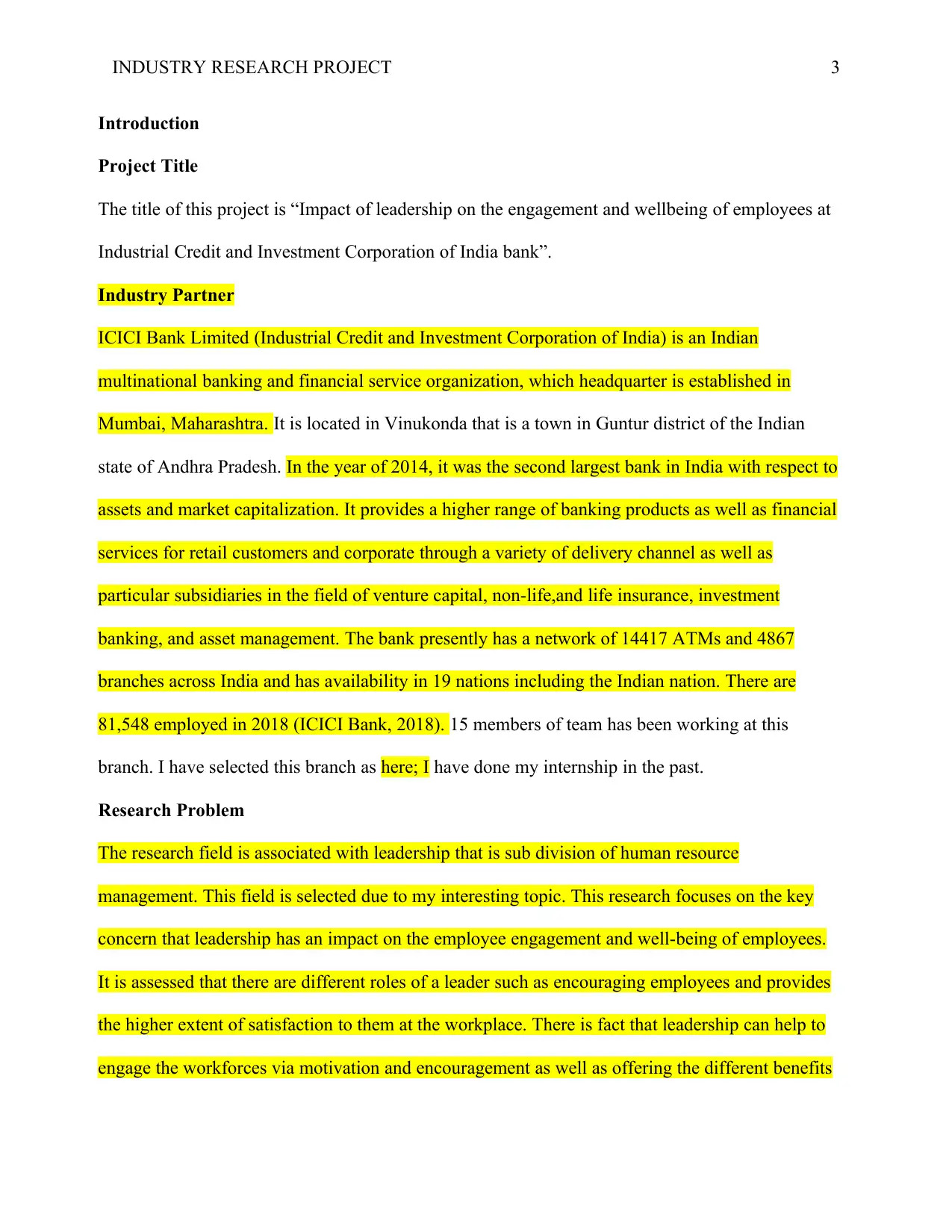
INDUSTRY RESEARCH PROJECT 3
Introduction
Project Title
The title of this project is “Impact of leadership on the engagement and wellbeing of employees at
Industrial Credit and Investment Corporation of India bank”.
Industry Partner
ICICI Bank Limited (Industrial Credit and Investment Corporation of India) is an Indian
multinational banking and financial service organization, which headquarter is established in
Mumbai, Maharashtra. It is located in Vinukonda that is a town in Guntur district of the Indian
state of Andhra Pradesh. In the year of 2014, it was the second largest bank in India with respect to
assets and market capitalization. It provides a higher range of banking products as well as financial
services for retail customers and corporate through a variety of delivery channel as well as
particular subsidiaries in the field of venture capital, non-life,and life insurance, investment
banking, and asset management. The bank presently has a network of 14417 ATMs and 4867
branches across India and has availability in 19 nations including the Indian nation. There are
81,548 employed in 2018 (ICICI Bank, 2018). 15 members of team has been working at this
branch. I have selected this branch as here; I have done my internship in the past.
Research Problem
The research field is associated with leadership that is sub division of human resource
management. This field is selected due to my interesting topic. This research focuses on the key
concern that leadership has an impact on the employee engagement and well-being of employees.
It is assessed that there are different roles of a leader such as encouraging employees and provides
the higher extent of satisfaction to them at the workplace. There is fact that leadership can help to
engage the workforces via motivation and encouragement as well as offering the different benefits
Introduction
Project Title
The title of this project is “Impact of leadership on the engagement and wellbeing of employees at
Industrial Credit and Investment Corporation of India bank”.
Industry Partner
ICICI Bank Limited (Industrial Credit and Investment Corporation of India) is an Indian
multinational banking and financial service organization, which headquarter is established in
Mumbai, Maharashtra. It is located in Vinukonda that is a town in Guntur district of the Indian
state of Andhra Pradesh. In the year of 2014, it was the second largest bank in India with respect to
assets and market capitalization. It provides a higher range of banking products as well as financial
services for retail customers and corporate through a variety of delivery channel as well as
particular subsidiaries in the field of venture capital, non-life,and life insurance, investment
banking, and asset management. The bank presently has a network of 14417 ATMs and 4867
branches across India and has availability in 19 nations including the Indian nation. There are
81,548 employed in 2018 (ICICI Bank, 2018). 15 members of team has been working at this
branch. I have selected this branch as here; I have done my internship in the past.
Research Problem
The research field is associated with leadership that is sub division of human resource
management. This field is selected due to my interesting topic. This research focuses on the key
concern that leadership has an impact on the employee engagement and well-being of employees.
It is assessed that there are different roles of a leader such as encouraging employees and provides
the higher extent of satisfaction to them at the workplace. There is fact that leadership can help to
engage the workforces via motivation and encouragement as well as offering the different benefits
⊘ This is a preview!⊘
Do you want full access?
Subscribe today to unlock all pages.

Trusted by 1+ million students worldwide
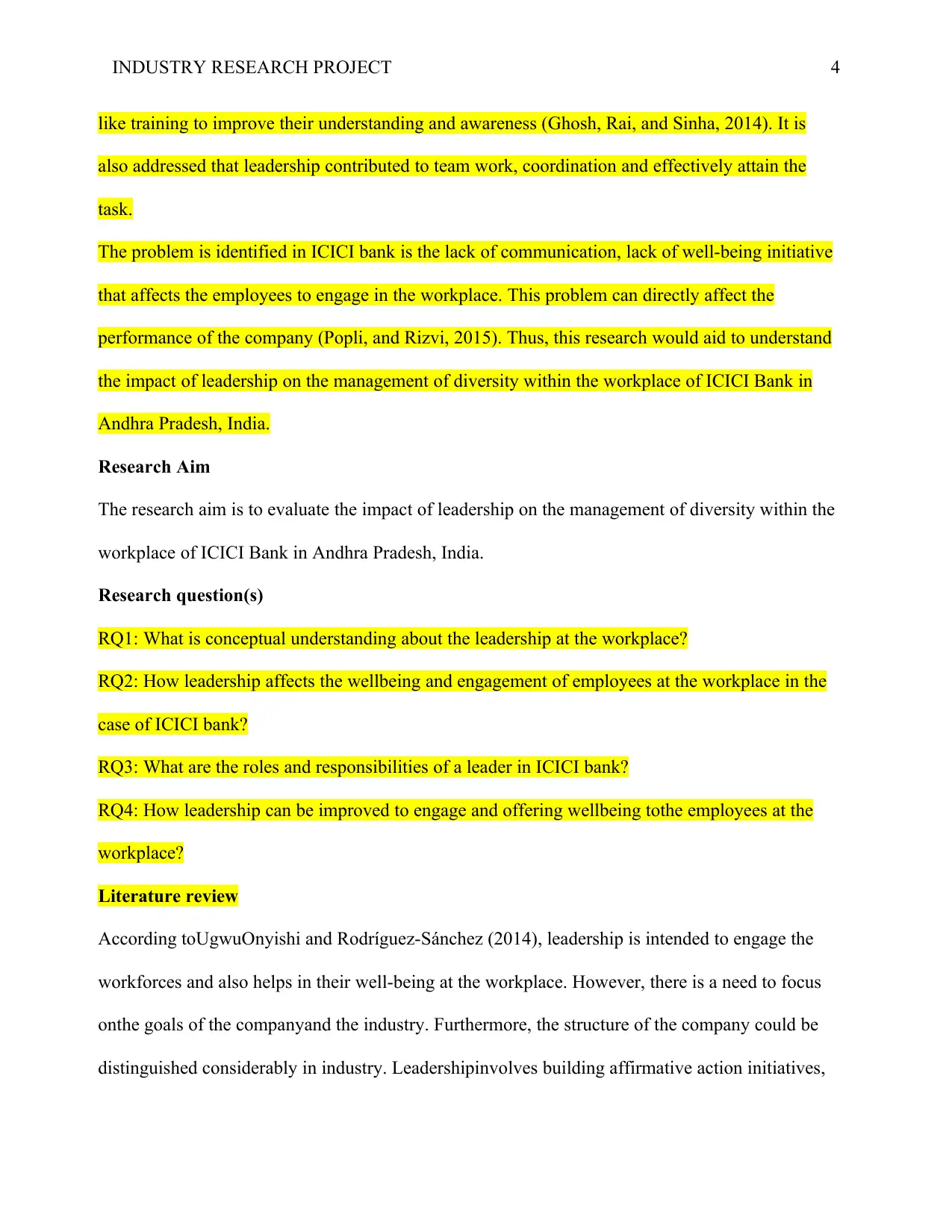
INDUSTRY RESEARCH PROJECT 4
like training to improve their understanding and awareness (Ghosh, Rai, and Sinha, 2014). It is
also addressed that leadership contributed to team work, coordination and effectively attain the
task.
The problem is identified in ICICI bank is the lack of communication, lack of well-being initiative
that affects the employees to engage in the workplace. This problem can directly affect the
performance of the company (Popli, and Rizvi, 2015). Thus, this research would aid to understand
the impact of leadership on the management of diversity within the workplace of ICICI Bank in
Andhra Pradesh, India.
Research Aim
The research aim is to evaluate the impact of leadership on the management of diversity within the
workplace of ICICI Bank in Andhra Pradesh, India.
Research question(s)
RQ1: What is conceptual understanding about the leadership at the workplace?
RQ2: How leadership affects the wellbeing and engagement of employees at the workplace in the
case of ICICI bank?
RQ3: What are the roles and responsibilities of a leader in ICICI bank?
RQ4: How leadership can be improved to engage and offering wellbeing tothe employees at the
workplace?
Literature review
According toUgwuOnyishi and Rodríguez-Sánchez (2014), leadership is intended to engage the
workforces and also helps in their well-being at the workplace. However, there is a need to focus
onthe goals of the companyand the industry. Furthermore, the structure of the company could be
distinguished considerably in industry. Leadershipinvolves building affirmative action initiatives,
like training to improve their understanding and awareness (Ghosh, Rai, and Sinha, 2014). It is
also addressed that leadership contributed to team work, coordination and effectively attain the
task.
The problem is identified in ICICI bank is the lack of communication, lack of well-being initiative
that affects the employees to engage in the workplace. This problem can directly affect the
performance of the company (Popli, and Rizvi, 2015). Thus, this research would aid to understand
the impact of leadership on the management of diversity within the workplace of ICICI Bank in
Andhra Pradesh, India.
Research Aim
The research aim is to evaluate the impact of leadership on the management of diversity within the
workplace of ICICI Bank in Andhra Pradesh, India.
Research question(s)
RQ1: What is conceptual understanding about the leadership at the workplace?
RQ2: How leadership affects the wellbeing and engagement of employees at the workplace in the
case of ICICI bank?
RQ3: What are the roles and responsibilities of a leader in ICICI bank?
RQ4: How leadership can be improved to engage and offering wellbeing tothe employees at the
workplace?
Literature review
According toUgwuOnyishi and Rodríguez-Sánchez (2014), leadership is intended to engage the
workforces and also helps in their well-being at the workplace. However, there is a need to focus
onthe goals of the companyand the industry. Furthermore, the structure of the company could be
distinguished considerably in industry. Leadershipinvolves building affirmative action initiatives,
Paraphrase This Document
Need a fresh take? Get an instant paraphrase of this document with our AI Paraphraser
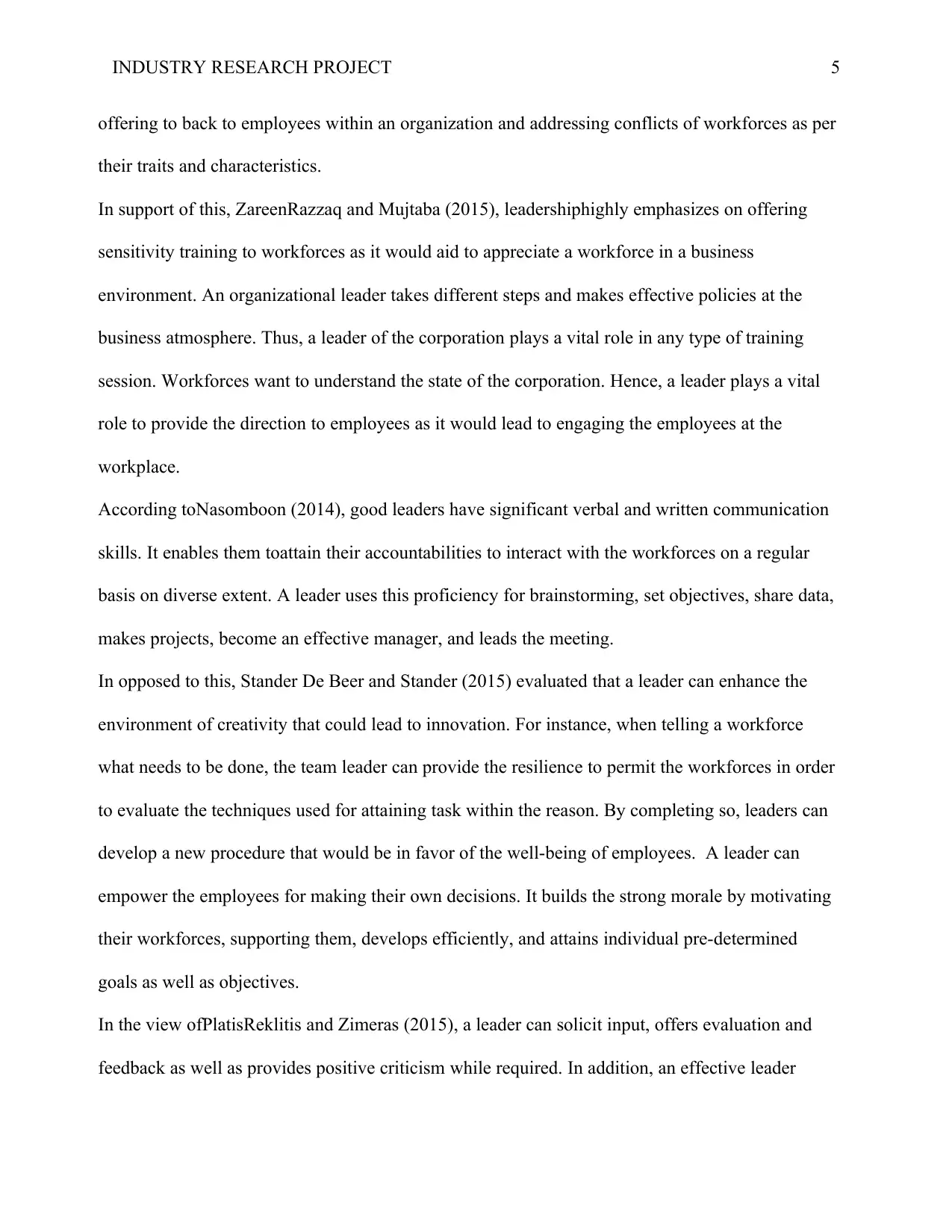
INDUSTRY RESEARCH PROJECT 5
offering to back to employees within an organization and addressing conflicts of workforces as per
their traits and characteristics.
In support of this, ZareenRazzaq and Mujtaba (2015), leadershiphighly emphasizes on offering
sensitivity training to workforces as it would aid to appreciate a workforce in a business
environment. An organizational leader takes different steps and makes effective policies at the
business atmosphere. Thus, a leader of the corporation plays a vital role in any type of training
session. Workforces want to understand the state of the corporation. Hence, a leader plays a vital
role to provide the direction to employees as it would lead to engaging the employees at the
workplace.
According toNasomboon (2014), good leaders have significant verbal and written communication
skills. It enables them toattain their accountabilities to interact with the workforces on a regular
basis on diverse extent. A leader uses this proficiency for brainstorming, set objectives, share data,
makes projects, become an effective manager, and leads the meeting.
In opposed to this, Stander De Beer and Stander (2015) evaluated that a leader can enhance the
environment of creativity that could lead to innovation. For instance, when telling a workforce
what needs to be done, the team leader can provide the resilience to permit the workforces in order
to evaluate the techniques used for attaining task within the reason. By completing so, leaders can
develop a new procedure that would be in favor of the well-being of employees. A leader can
empower the employees for making their own decisions. It builds the strong morale by motivating
their workforces, supporting them, develops efficiently, and attains individual pre-determined
goals as well as objectives.
In the view ofPlatisReklitis and Zimeras (2015), a leader can solicit input, offers evaluation and
feedback as well as provides positive criticism while required. In addition, an effective leader
offering to back to employees within an organization and addressing conflicts of workforces as per
their traits and characteristics.
In support of this, ZareenRazzaq and Mujtaba (2015), leadershiphighly emphasizes on offering
sensitivity training to workforces as it would aid to appreciate a workforce in a business
environment. An organizational leader takes different steps and makes effective policies at the
business atmosphere. Thus, a leader of the corporation plays a vital role in any type of training
session. Workforces want to understand the state of the corporation. Hence, a leader plays a vital
role to provide the direction to employees as it would lead to engaging the employees at the
workplace.
According toNasomboon (2014), good leaders have significant verbal and written communication
skills. It enables them toattain their accountabilities to interact with the workforces on a regular
basis on diverse extent. A leader uses this proficiency for brainstorming, set objectives, share data,
makes projects, become an effective manager, and leads the meeting.
In opposed to this, Stander De Beer and Stander (2015) evaluated that a leader can enhance the
environment of creativity that could lead to innovation. For instance, when telling a workforce
what needs to be done, the team leader can provide the resilience to permit the workforces in order
to evaluate the techniques used for attaining task within the reason. By completing so, leaders can
develop a new procedure that would be in favor of the well-being of employees. A leader can
empower the employees for making their own decisions. It builds the strong morale by motivating
their workforces, supporting them, develops efficiently, and attains individual pre-determined
goals as well as objectives.
In the view ofPlatisReklitis and Zimeras (2015), a leader can solicit input, offers evaluation and
feedback as well as provides positive criticism while required. In addition, an effective leader
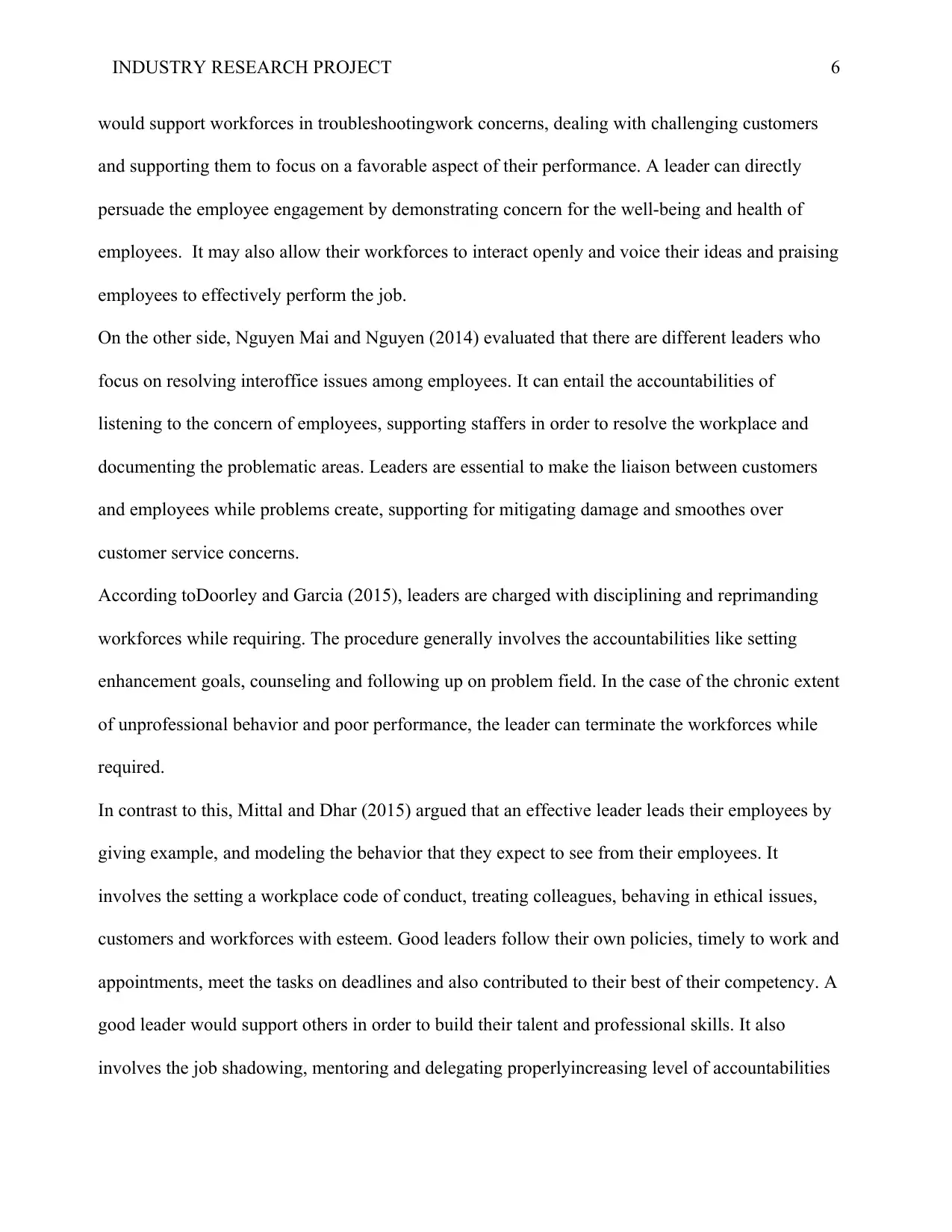
INDUSTRY RESEARCH PROJECT 6
would support workforces in troubleshootingwork concerns, dealing with challenging customers
and supporting them to focus on a favorable aspect of their performance. A leader can directly
persuade the employee engagement by demonstrating concern for the well-being and health of
employees. It may also allow their workforces to interact openly and voice their ideas and praising
employees to effectively perform the job.
On the other side, Nguyen Mai and Nguyen (2014) evaluated that there are different leaders who
focus on resolving interoffice issues among employees. It can entail the accountabilities of
listening to the concern of employees, supporting staffers in order to resolve the workplace and
documenting the problematic areas. Leaders are essential to make the liaison between customers
and employees while problems create, supporting for mitigating damage and smoothes over
customer service concerns.
According toDoorley and Garcia (2015), leaders are charged with disciplining and reprimanding
workforces while requiring. The procedure generally involves the accountabilities like setting
enhancement goals, counseling and following up on problem field. In the case of the chronic extent
of unprofessional behavior and poor performance, the leader can terminate the workforces while
required.
In contrast to this, Mittal and Dhar (2015) argued that an effective leader leads their employees by
giving example, and modeling the behavior that they expect to see from their employees. It
involves the setting a workplace code of conduct, treating colleagues, behaving in ethical issues,
customers and workforces with esteem. Good leaders follow their own policies, timely to work and
appointments, meet the tasks on deadlines and also contributed to their best of their competency. A
good leader would support others in order to build their talent and professional skills. It also
involves the job shadowing, mentoring and delegating properlyincreasing level of accountabilities
would support workforces in troubleshootingwork concerns, dealing with challenging customers
and supporting them to focus on a favorable aspect of their performance. A leader can directly
persuade the employee engagement by demonstrating concern for the well-being and health of
employees. It may also allow their workforces to interact openly and voice their ideas and praising
employees to effectively perform the job.
On the other side, Nguyen Mai and Nguyen (2014) evaluated that there are different leaders who
focus on resolving interoffice issues among employees. It can entail the accountabilities of
listening to the concern of employees, supporting staffers in order to resolve the workplace and
documenting the problematic areas. Leaders are essential to make the liaison between customers
and employees while problems create, supporting for mitigating damage and smoothes over
customer service concerns.
According toDoorley and Garcia (2015), leaders are charged with disciplining and reprimanding
workforces while requiring. The procedure generally involves the accountabilities like setting
enhancement goals, counseling and following up on problem field. In the case of the chronic extent
of unprofessional behavior and poor performance, the leader can terminate the workforces while
required.
In contrast to this, Mittal and Dhar (2015) argued that an effective leader leads their employees by
giving example, and modeling the behavior that they expect to see from their employees. It
involves the setting a workplace code of conduct, treating colleagues, behaving in ethical issues,
customers and workforces with esteem. Good leaders follow their own policies, timely to work and
appointments, meet the tasks on deadlines and also contributed to their best of their competency. A
good leader would support others in order to build their talent and professional skills. It also
involves the job shadowing, mentoring and delegating properlyincreasing level of accountabilities
⊘ This is a preview!⊘
Do you want full access?
Subscribe today to unlock all pages.

Trusted by 1+ million students worldwide
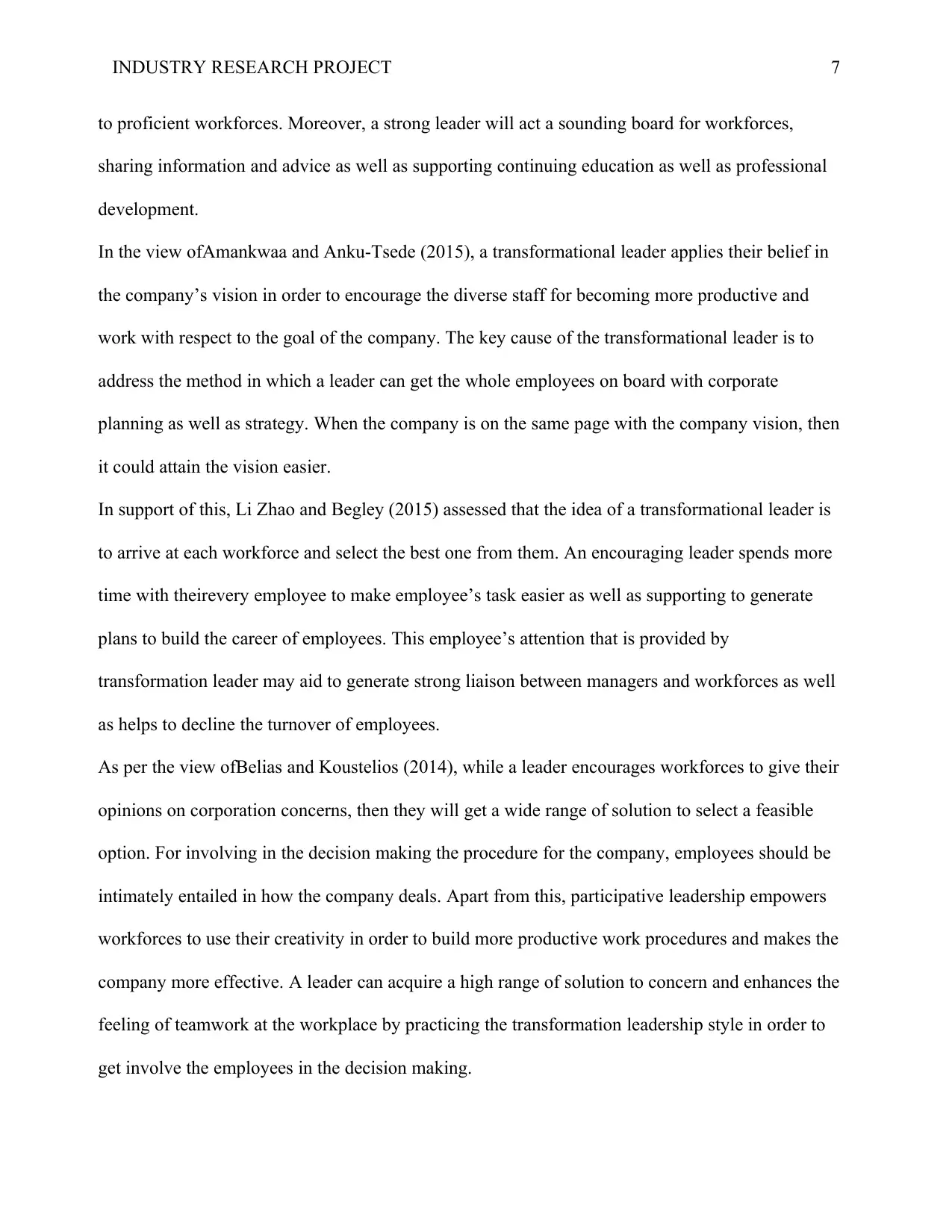
INDUSTRY RESEARCH PROJECT 7
to proficient workforces. Moreover, a strong leader will act a sounding board for workforces,
sharing information and advice as well as supporting continuing education as well as professional
development.
In the view ofAmankwaa and Anku-Tsede (2015), a transformational leader applies their belief in
the company’s vision in order to encourage the diverse staff for becoming more productive and
work with respect to the goal of the company. The key cause of the transformational leader is to
address the method in which a leader can get the whole employees on board with corporate
planning as well as strategy. When the company is on the same page with the company vision, then
it could attain the vision easier.
In support of this, Li Zhao and Begley (2015) assessed that the idea of a transformational leader is
to arrive at each workforce and select the best one from them. An encouraging leader spends more
time with theirevery employee to make employee’s task easier as well as supporting to generate
plans to build the career of employees. This employee’s attention that is provided by
transformation leader may aid to generate strong liaison between managers and workforces as well
as helps to decline the turnover of employees.
As per the view ofBelias and Koustelios (2014), while a leader encourages workforces to give their
opinions on corporation concerns, then they will get a wide range of solution to select a feasible
option. For involving in the decision making the procedure for the company, employees should be
intimately entailed in how the company deals. Apart from this, participative leadership empowers
workforces to use their creativity in order to build more productive work procedures and makes the
company more effective. A leader can acquire a high range of solution to concern and enhances the
feeling of teamwork at the workplace by practicing the transformation leadership style in order to
get involve the employees in the decision making.
to proficient workforces. Moreover, a strong leader will act a sounding board for workforces,
sharing information and advice as well as supporting continuing education as well as professional
development.
In the view ofAmankwaa and Anku-Tsede (2015), a transformational leader applies their belief in
the company’s vision in order to encourage the diverse staff for becoming more productive and
work with respect to the goal of the company. The key cause of the transformational leader is to
address the method in which a leader can get the whole employees on board with corporate
planning as well as strategy. When the company is on the same page with the company vision, then
it could attain the vision easier.
In support of this, Li Zhao and Begley (2015) assessed that the idea of a transformational leader is
to arrive at each workforce and select the best one from them. An encouraging leader spends more
time with theirevery employee to make employee’s task easier as well as supporting to generate
plans to build the career of employees. This employee’s attention that is provided by
transformation leader may aid to generate strong liaison between managers and workforces as well
as helps to decline the turnover of employees.
As per the view ofBelias and Koustelios (2014), while a leader encourages workforces to give their
opinions on corporation concerns, then they will get a wide range of solution to select a feasible
option. For involving in the decision making the procedure for the company, employees should be
intimately entailed in how the company deals. Apart from this, participative leadership empowers
workforces to use their creativity in order to build more productive work procedures and makes the
company more effective. A leader can acquire a high range of solution to concern and enhances the
feeling of teamwork at the workplace by practicing the transformation leadership style in order to
get involve the employees in the decision making.
Paraphrase This Document
Need a fresh take? Get an instant paraphrase of this document with our AI Paraphraser
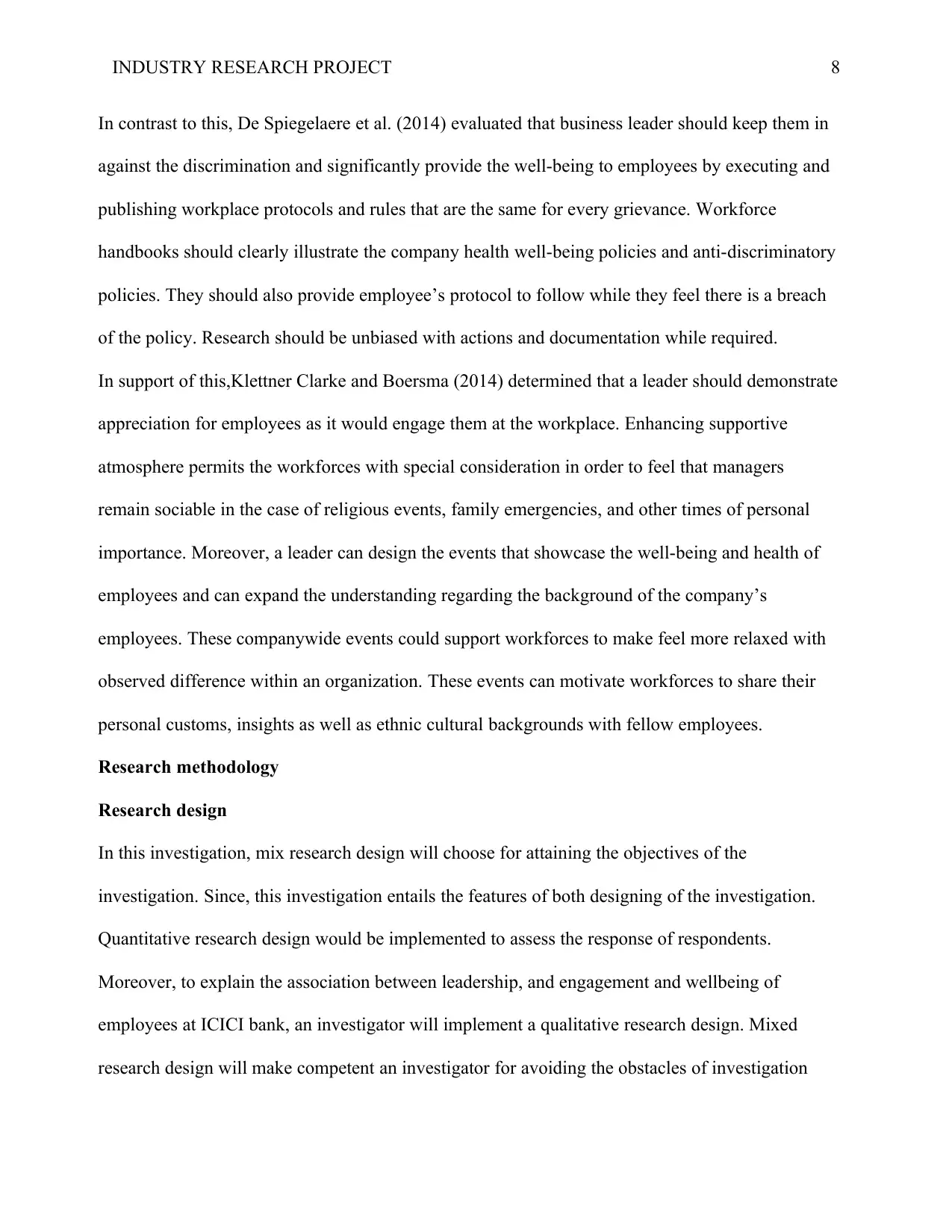
INDUSTRY RESEARCH PROJECT 8
In contrast to this, De Spiegelaere et al. (2014) evaluated that business leader should keep them in
against the discrimination and significantly provide the well-being to employees by executing and
publishing workplace protocols and rules that are the same for every grievance. Workforce
handbooks should clearly illustrate the company health well-being policies and anti-discriminatory
policies. They should also provide employee’s protocol to follow while they feel there is a breach
of the policy. Research should be unbiased with actions and documentation while required.
In support of this,Klettner Clarke and Boersma (2014) determined that a leader should demonstrate
appreciation for employees as it would engage them at the workplace. Enhancing supportive
atmosphere permits the workforces with special consideration in order to feel that managers
remain sociable in the case of religious events, family emergencies, and other times of personal
importance. Moreover, a leader can design the events that showcase the well-being and health of
employees and can expand the understanding regarding the background of the company’s
employees. These companywide events could support workforces to make feel more relaxed with
observed difference within an organization. These events can motivate workforces to share their
personal customs, insights as well as ethnic cultural backgrounds with fellow employees.
Research methodology
Research design
In this investigation, mix research design will choose for attaining the objectives of the
investigation. Since, this investigation entails the features of both designing of the investigation.
Quantitative research design would be implemented to assess the response of respondents.
Moreover, to explain the association between leadership, and engagement and wellbeing of
employees at ICICI bank, an investigator will implement a qualitative research design. Mixed
research design will make competent an investigator for avoiding the obstacles of investigation
In contrast to this, De Spiegelaere et al. (2014) evaluated that business leader should keep them in
against the discrimination and significantly provide the well-being to employees by executing and
publishing workplace protocols and rules that are the same for every grievance. Workforce
handbooks should clearly illustrate the company health well-being policies and anti-discriminatory
policies. They should also provide employee’s protocol to follow while they feel there is a breach
of the policy. Research should be unbiased with actions and documentation while required.
In support of this,Klettner Clarke and Boersma (2014) determined that a leader should demonstrate
appreciation for employees as it would engage them at the workplace. Enhancing supportive
atmosphere permits the workforces with special consideration in order to feel that managers
remain sociable in the case of religious events, family emergencies, and other times of personal
importance. Moreover, a leader can design the events that showcase the well-being and health of
employees and can expand the understanding regarding the background of the company’s
employees. These companywide events could support workforces to make feel more relaxed with
observed difference within an organization. These events can motivate workforces to share their
personal customs, insights as well as ethnic cultural backgrounds with fellow employees.
Research methodology
Research design
In this investigation, mix research design will choose for attaining the objectives of the
investigation. Since, this investigation entails the features of both designing of the investigation.
Quantitative research design would be implemented to assess the response of respondents.
Moreover, to explain the association between leadership, and engagement and wellbeing of
employees at ICICI bank, an investigator will implement a qualitative research design. Mixed
research design will make competent an investigator for avoiding the obstacles of investigation
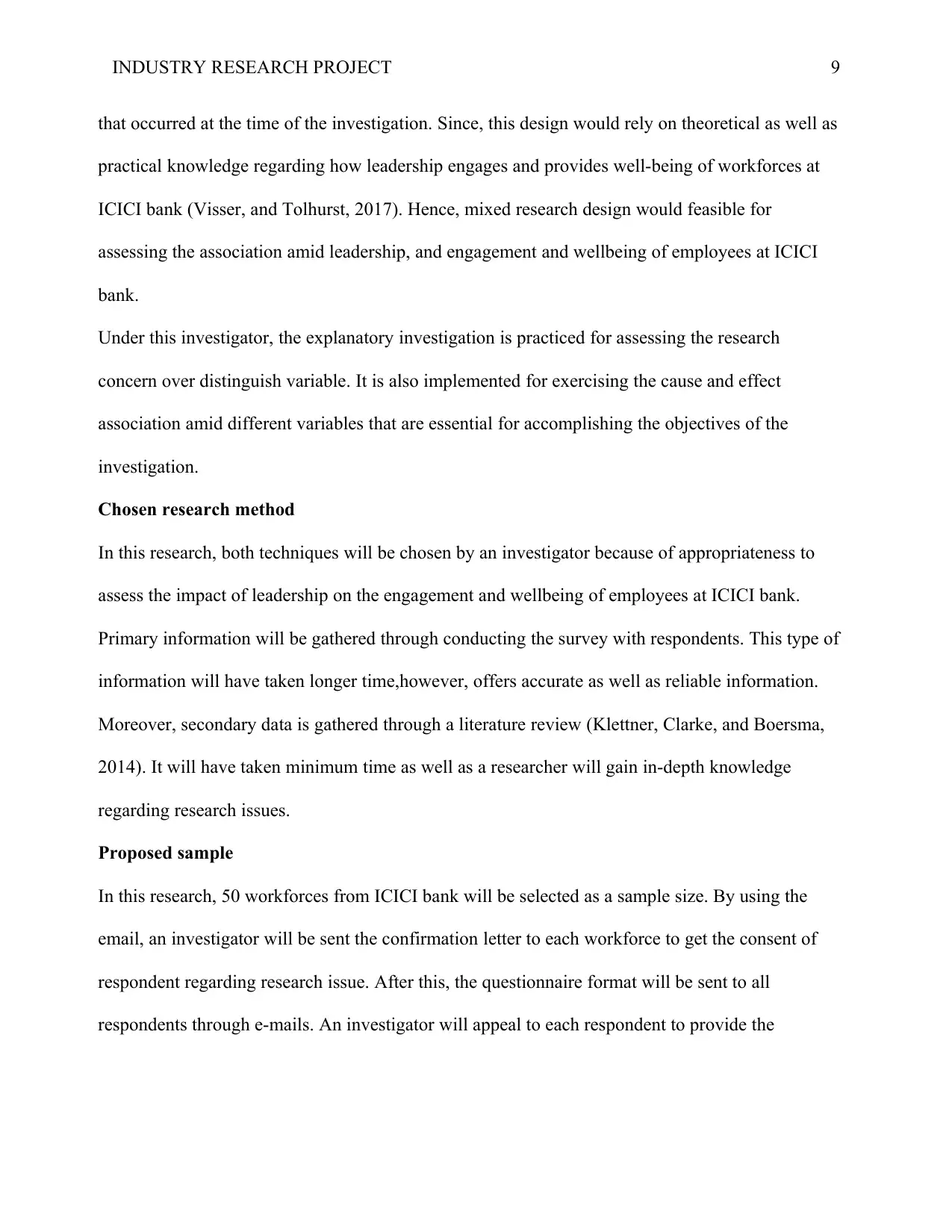
INDUSTRY RESEARCH PROJECT 9
that occurred at the time of the investigation. Since, this design would rely on theoretical as well as
practical knowledge regarding how leadership engages and provides well-being of workforces at
ICICI bank (Visser, and Tolhurst, 2017). Hence, mixed research design would feasible for
assessing the association amid leadership, and engagement and wellbeing of employees at ICICI
bank.
Under this investigator, the explanatory investigation is practiced for assessing the research
concern over distinguish variable. It is also implemented for exercising the cause and effect
association amid different variables that are essential for accomplishing the objectives of the
investigation.
Chosen research method
In this research, both techniques will be chosen by an investigator because of appropriateness to
assess the impact of leadership on the engagement and wellbeing of employees at ICICI bank.
Primary information will be gathered through conducting the survey with respondents. This type of
information will have taken longer time,however, offers accurate as well as reliable information.
Moreover, secondary data is gathered through a literature review (Klettner, Clarke, and Boersma,
2014). It will have taken minimum time as well as a researcher will gain in-depth knowledge
regarding research issues.
Proposed sample
In this research, 50 workforces from ICICI bank will be selected as a sample size. By using the
email, an investigator will be sent the confirmation letter to each workforce to get the consent of
respondent regarding research issue. After this, the questionnaire format will be sent to all
respondents through e-mails. An investigator will appeal to each respondent to provide the
that occurred at the time of the investigation. Since, this design would rely on theoretical as well as
practical knowledge regarding how leadership engages and provides well-being of workforces at
ICICI bank (Visser, and Tolhurst, 2017). Hence, mixed research design would feasible for
assessing the association amid leadership, and engagement and wellbeing of employees at ICICI
bank.
Under this investigator, the explanatory investigation is practiced for assessing the research
concern over distinguish variable. It is also implemented for exercising the cause and effect
association amid different variables that are essential for accomplishing the objectives of the
investigation.
Chosen research method
In this research, both techniques will be chosen by an investigator because of appropriateness to
assess the impact of leadership on the engagement and wellbeing of employees at ICICI bank.
Primary information will be gathered through conducting the survey with respondents. This type of
information will have taken longer time,however, offers accurate as well as reliable information.
Moreover, secondary data is gathered through a literature review (Klettner, Clarke, and Boersma,
2014). It will have taken minimum time as well as a researcher will gain in-depth knowledge
regarding research issues.
Proposed sample
In this research, 50 workforces from ICICI bank will be selected as a sample size. By using the
email, an investigator will be sent the confirmation letter to each workforce to get the consent of
respondent regarding research issue. After this, the questionnaire format will be sent to all
respondents through e-mails. An investigator will appeal to each respondent to provide the
⊘ This is a preview!⊘
Do you want full access?
Subscribe today to unlock all pages.

Trusted by 1+ million students worldwide
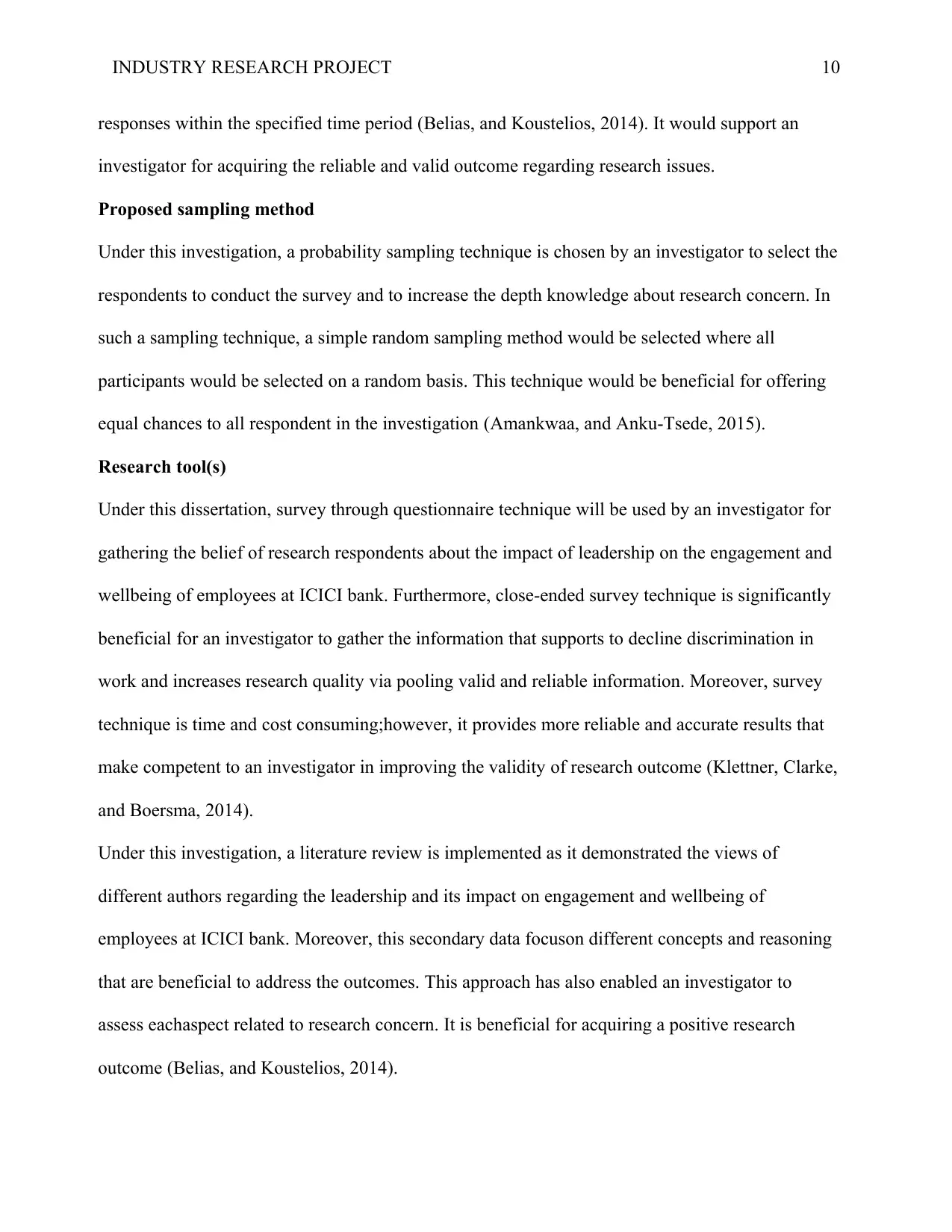
INDUSTRY RESEARCH PROJECT 10
responses within the specified time period (Belias, and Koustelios, 2014). It would support an
investigator for acquiring the reliable and valid outcome regarding research issues.
Proposed sampling method
Under this investigation, a probability sampling technique is chosen by an investigator to select the
respondents to conduct the survey and to increase the depth knowledge about research concern. In
such a sampling technique, a simple random sampling method would be selected where all
participants would be selected on a random basis. This technique would be beneficial for offering
equal chances to all respondent in the investigation (Amankwaa, and Anku-Tsede, 2015).
Research tool(s)
Under this dissertation, survey through questionnaire technique will be used by an investigator for
gathering the belief of research respondents about the impact of leadership on the engagement and
wellbeing of employees at ICICI bank. Furthermore, close-ended survey technique is significantly
beneficial for an investigator to gather the information that supports to decline discrimination in
work and increases research quality via pooling valid and reliable information. Moreover, survey
technique is time and cost consuming;however, it provides more reliable and accurate results that
make competent to an investigator in improving the validity of research outcome (Klettner, Clarke,
and Boersma, 2014).
Under this investigation, a literature review is implemented as it demonstrated the views of
different authors regarding the leadership and its impact on engagement and wellbeing of
employees at ICICI bank. Moreover, this secondary data focuson different concepts and reasoning
that are beneficial to address the outcomes. This approach has also enabled an investigator to
assess eachaspect related to research concern. It is beneficial for acquiring a positive research
outcome (Belias, and Koustelios, 2014).
responses within the specified time period (Belias, and Koustelios, 2014). It would support an
investigator for acquiring the reliable and valid outcome regarding research issues.
Proposed sampling method
Under this investigation, a probability sampling technique is chosen by an investigator to select the
respondents to conduct the survey and to increase the depth knowledge about research concern. In
such a sampling technique, a simple random sampling method would be selected where all
participants would be selected on a random basis. This technique would be beneficial for offering
equal chances to all respondent in the investigation (Amankwaa, and Anku-Tsede, 2015).
Research tool(s)
Under this dissertation, survey through questionnaire technique will be used by an investigator for
gathering the belief of research respondents about the impact of leadership on the engagement and
wellbeing of employees at ICICI bank. Furthermore, close-ended survey technique is significantly
beneficial for an investigator to gather the information that supports to decline discrimination in
work and increases research quality via pooling valid and reliable information. Moreover, survey
technique is time and cost consuming;however, it provides more reliable and accurate results that
make competent to an investigator in improving the validity of research outcome (Klettner, Clarke,
and Boersma, 2014).
Under this investigation, a literature review is implemented as it demonstrated the views of
different authors regarding the leadership and its impact on engagement and wellbeing of
employees at ICICI bank. Moreover, this secondary data focuson different concepts and reasoning
that are beneficial to address the outcomes. This approach has also enabled an investigator to
assess eachaspect related to research concern. It is beneficial for acquiring a positive research
outcome (Belias, and Koustelios, 2014).
Paraphrase This Document
Need a fresh take? Get an instant paraphrase of this document with our AI Paraphraser
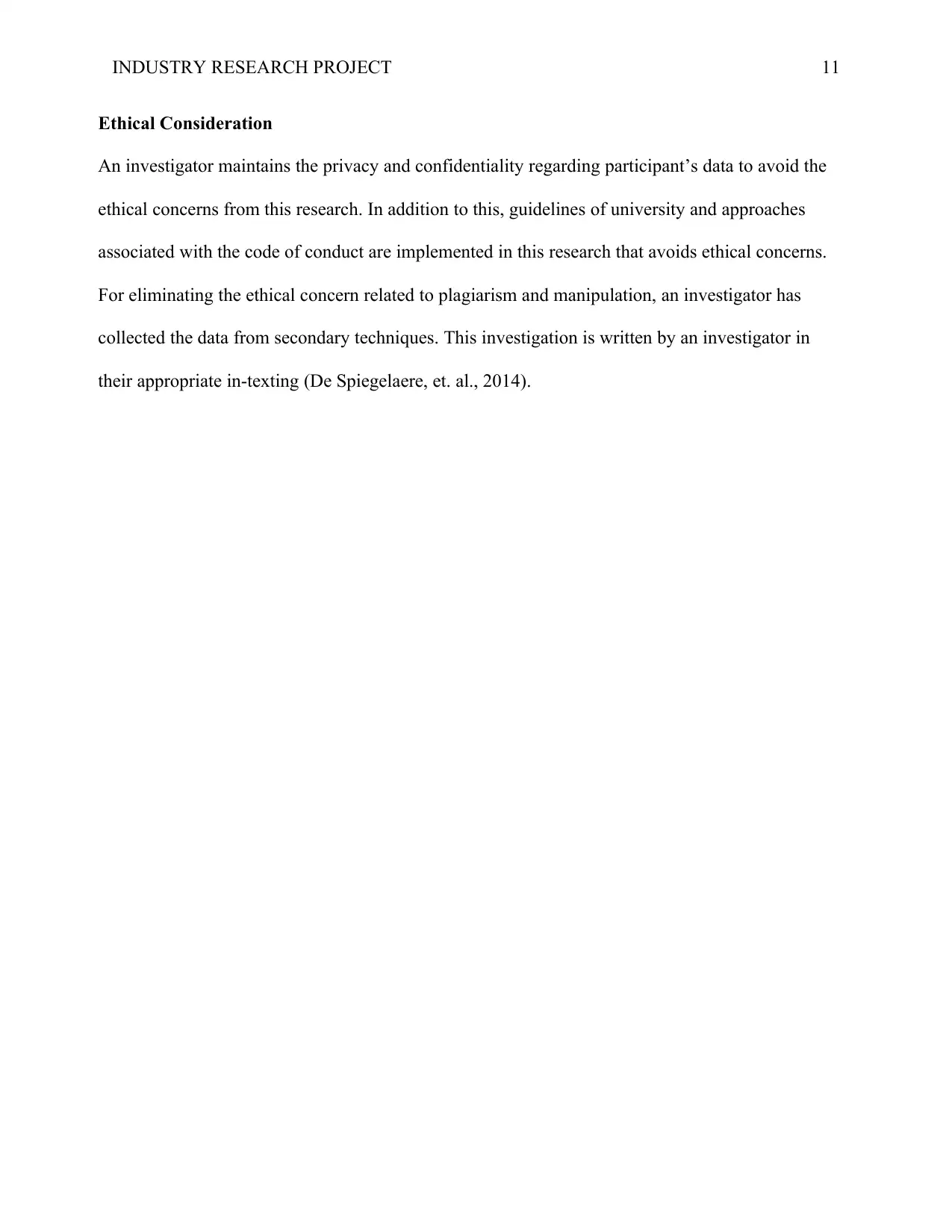
INDUSTRY RESEARCH PROJECT 11
Ethical Consideration
An investigator maintains the privacy and confidentiality regarding participant’s data to avoid the
ethical concerns from this research. In addition to this, guidelines of university and approaches
associated with the code of conduct are implemented in this research that avoids ethical concerns.
For eliminating the ethical concern related to plagiarism and manipulation, an investigator has
collected the data from secondary techniques. This investigation is written by an investigator in
their appropriate in-texting (De Spiegelaere, et. al., 2014).
Ethical Consideration
An investigator maintains the privacy and confidentiality regarding participant’s data to avoid the
ethical concerns from this research. In addition to this, guidelines of university and approaches
associated with the code of conduct are implemented in this research that avoids ethical concerns.
For eliminating the ethical concern related to plagiarism and manipulation, an investigator has
collected the data from secondary techniques. This investigation is written by an investigator in
their appropriate in-texting (De Spiegelaere, et. al., 2014).
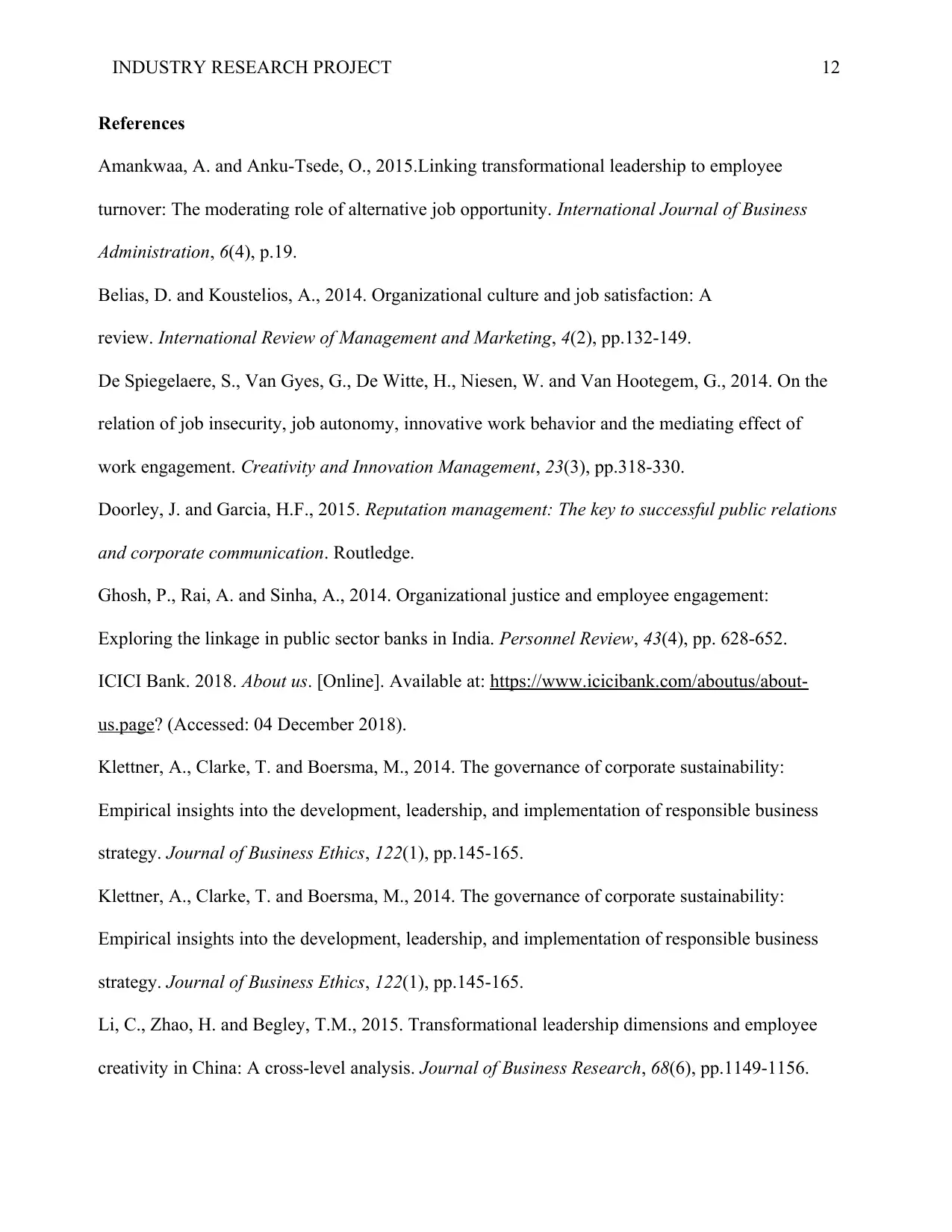
INDUSTRY RESEARCH PROJECT 12
References
Amankwaa, A. and Anku-Tsede, O., 2015.Linking transformational leadership to employee
turnover: The moderating role of alternative job opportunity. International Journal of Business
Administration, 6(4), p.19.
Belias, D. and Koustelios, A., 2014. Organizational culture and job satisfaction: A
review. International Review of Management and Marketing, 4(2), pp.132-149.
De Spiegelaere, S., Van Gyes, G., De Witte, H., Niesen, W. and Van Hootegem, G., 2014. On the
relation of job insecurity, job autonomy, innovative work behavior and the mediating effect of
work engagement. Creativity and Innovation Management, 23(3), pp.318-330.
Doorley, J. and Garcia, H.F., 2015. Reputation management: The key to successful public relations
and corporate communication. Routledge.
Ghosh, P., Rai, A. and Sinha, A., 2014. Organizational justice and employee engagement:
Exploring the linkage in public sector banks in India. Personnel Review, 43(4), pp. 628-652.
ICICI Bank. 2018. About us. [Online]. Available at: https://www.icicibank.com/aboutus/about-
us.page? (Accessed: 04 December 2018).
Klettner, A., Clarke, T. and Boersma, M., 2014. The governance of corporate sustainability:
Empirical insights into the development, leadership, and implementation of responsible business
strategy. Journal of Business Ethics, 122(1), pp.145-165.
Klettner, A., Clarke, T. and Boersma, M., 2014. The governance of corporate sustainability:
Empirical insights into the development, leadership, and implementation of responsible business
strategy. Journal of Business Ethics, 122(1), pp.145-165.
Li, C., Zhao, H. and Begley, T.M., 2015. Transformational leadership dimensions and employee
creativity in China: A cross-level analysis. Journal of Business Research, 68(6), pp.1149-1156.
References
Amankwaa, A. and Anku-Tsede, O., 2015.Linking transformational leadership to employee
turnover: The moderating role of alternative job opportunity. International Journal of Business
Administration, 6(4), p.19.
Belias, D. and Koustelios, A., 2014. Organizational culture and job satisfaction: A
review. International Review of Management and Marketing, 4(2), pp.132-149.
De Spiegelaere, S., Van Gyes, G., De Witte, H., Niesen, W. and Van Hootegem, G., 2014. On the
relation of job insecurity, job autonomy, innovative work behavior and the mediating effect of
work engagement. Creativity and Innovation Management, 23(3), pp.318-330.
Doorley, J. and Garcia, H.F., 2015. Reputation management: The key to successful public relations
and corporate communication. Routledge.
Ghosh, P., Rai, A. and Sinha, A., 2014. Organizational justice and employee engagement:
Exploring the linkage in public sector banks in India. Personnel Review, 43(4), pp. 628-652.
ICICI Bank. 2018. About us. [Online]. Available at: https://www.icicibank.com/aboutus/about-
us.page? (Accessed: 04 December 2018).
Klettner, A., Clarke, T. and Boersma, M., 2014. The governance of corporate sustainability:
Empirical insights into the development, leadership, and implementation of responsible business
strategy. Journal of Business Ethics, 122(1), pp.145-165.
Klettner, A., Clarke, T. and Boersma, M., 2014. The governance of corporate sustainability:
Empirical insights into the development, leadership, and implementation of responsible business
strategy. Journal of Business Ethics, 122(1), pp.145-165.
Li, C., Zhao, H. and Begley, T.M., 2015. Transformational leadership dimensions and employee
creativity in China: A cross-level analysis. Journal of Business Research, 68(6), pp.1149-1156.
⊘ This is a preview!⊘
Do you want full access?
Subscribe today to unlock all pages.

Trusted by 1+ million students worldwide
1 out of 14
Related Documents
Your All-in-One AI-Powered Toolkit for Academic Success.
+13062052269
info@desklib.com
Available 24*7 on WhatsApp / Email
![[object Object]](/_next/static/media/star-bottom.7253800d.svg)
Unlock your academic potential
Copyright © 2020–2025 A2Z Services. All Rights Reserved. Developed and managed by ZUCOL.



